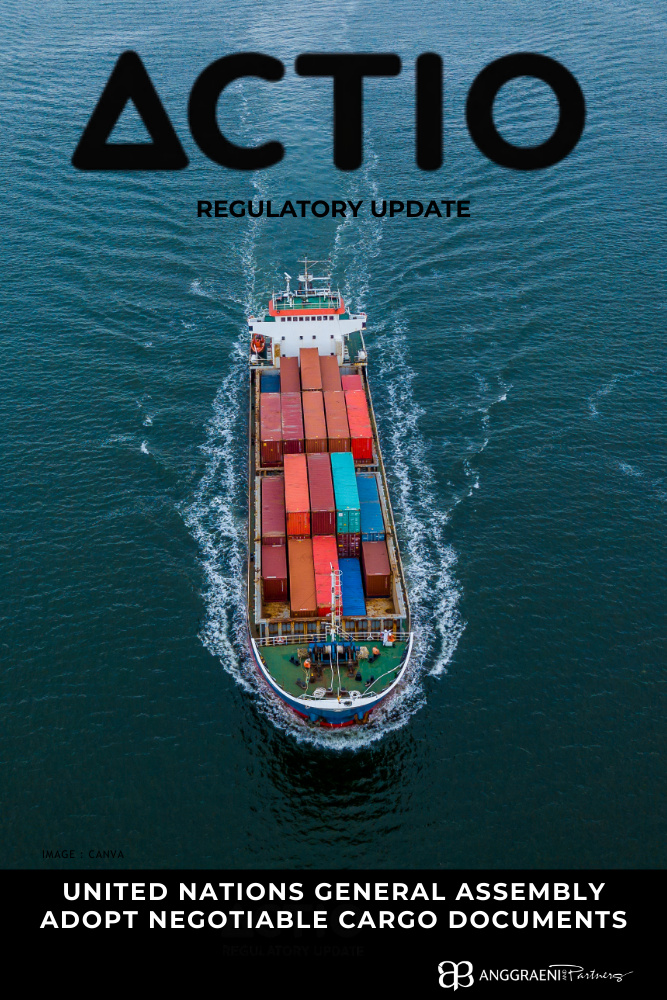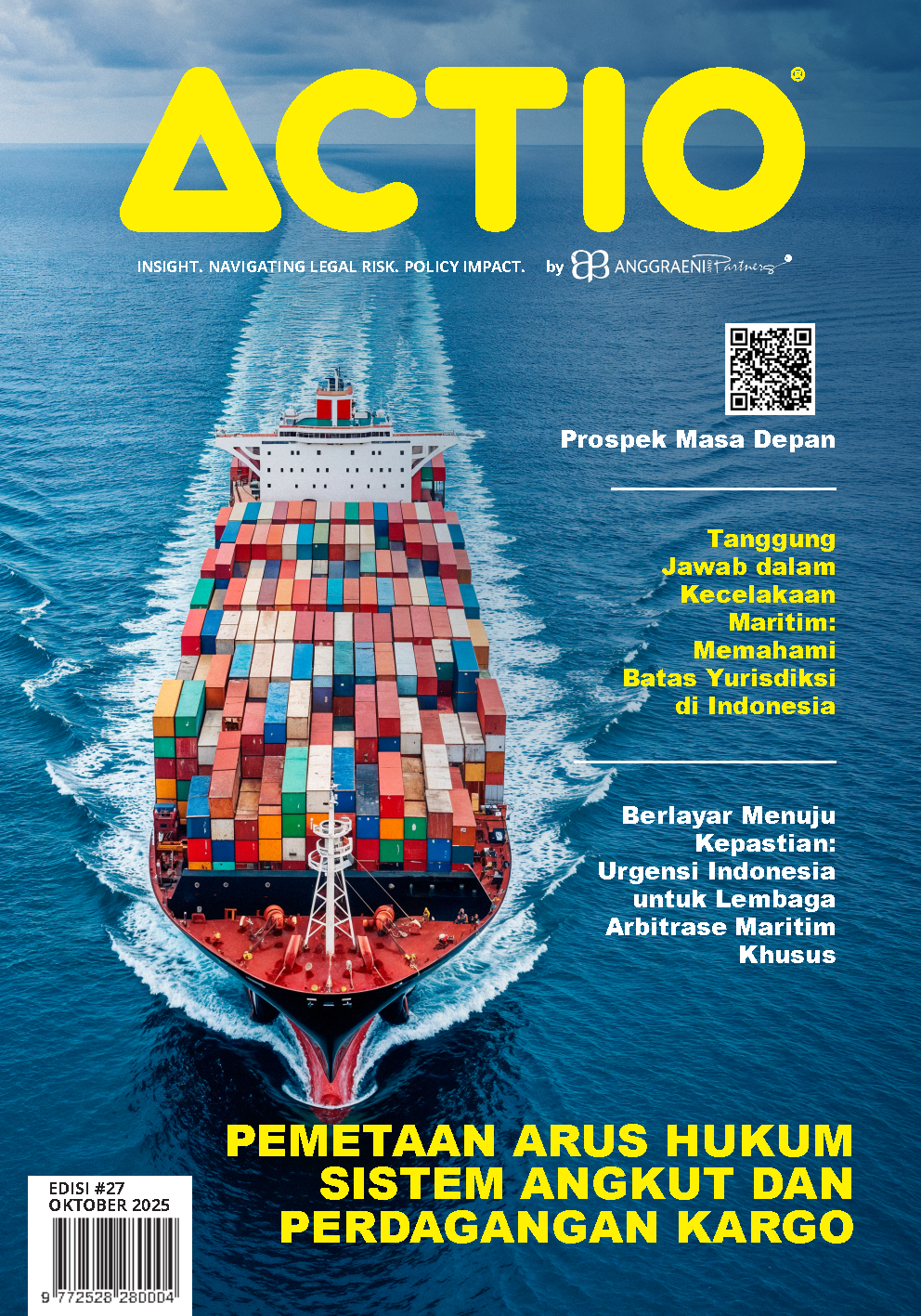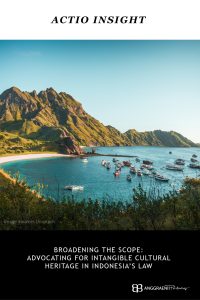Broadening the Scope : Advocating for Intangible Cultural Heritage in Indonesia’s Law
by Setyawati Fitrianggraeni, Fildza Nabila Avianti, Sri Purnama[1]
Research Group Ocean Maritime and Climate, Working Committee Business and Human Right
INTRODUCTION
Spanning from Sabang to Merauke, Indonesia boasts the world’s largest archipelago, consisting of tens of thousands of islands. These islands are geographically significant and rich tapestries of ancient human civilisations, each replete with distinct cultures that define the nation’s identity.[2] Central to these cultures are traditions, which can be conceptualised as the transmission or inheritance of norms, values, customs, and treasures across generations.
To enshrine and safeguard this rich historical and cultural legacy, reflecting the nation’s core values stipulated in Article 32 of the 1945 Constitution of the Republic of Indonesia (“UUD NRI 1945”), the State[3] instituted specific legislation protecting cultural heritage. Initially, this took the form of Law Number 5 of 1992 concerning Cultural Heritage Objects (“Cultural Heritage Objects Law”). However, due to evolving societal demands and the increasing misalignment of the law’s provisions with contemporary developments, it was superseded by Law Number 11 of 2010 concerning Cultural Heritage (“Cultural Heritage Law”).
Indonesia’s legislative thrust in this realm is anchored in its broader commitment to safeguard cultural heritage, a pledge underscored by its ratification of international conventions like the 1972 Convention on the Protection of World Cultural and Natural Heritage and the Convention on Intangible Cultural Heritage in 2003. These instruments emphasise the imperative of cultural preservation and consequently confer upon the State the duty to protect its indigenous populations’ rights and cultural heritage.
The Cultural Heritage Law defines cultural heritage as the embodiment of a nation’s cultural wealth, manifesting in thought and behaviour patterns, pivotal for grasping and evolving history, science, and culture in society.[4] Therefore, it necessitates scrupulous management through protection, enrichment, and utilisation aimed at fostering a national culture to ensure the collective welfare of the citizenry.
Whilst the Cultural Heritage Law recognises tangible and intangible aspects of heritage, there is a pronounced emphasis on the tangible.[5] Remarkably, even after an 18-year legislative journey, commencing with the Cultural Heritage Objects Law in 1992 and culminating in the 2010 Cultural Heritage Law, the existing regulations seem insufficient, especially regarding the protection of intangible cultural heritage.
This article grapples with three seminal queries:
- How does Indonesia’s law address cultural heritage? We shall delve into the Cultural Heritage Law’s provisions to unpack this.
- Do these regulations adequately safeguard all facets of cultural heritage, with a particular focus on intangible aspects? If there are lacunae, what rectifications are imperative?
- Should there be a call for legislative amendments, what are the foreseeable ramifications of such changes on protecting intangible cultural heritage?
Our objective is to furnish a refreshed perspective on Indonesia’s cultural heritage regulations, accentuating the pivotal realm of intangible heritage.
EXAMINATION OF CURRENT PROVISIONS IN CULTURAL HERITAGE LAW
With its cultural tapestry woven across various regions, Indonesia acknowledges that the nation’s cultural patrimony not only stands as a testament to its historical, scientific, and socio-cultural evolution but also acts as a beacon, fostering a profound consciousness of the Indonesian national identity. The imperative to shield this rich legacy led the Government to promulgate the Cultural Heritage Law, succeeding the antiquated Cultural Heritage Objects Law, which had become misaligned with contemporary societal exigencies and legal imperatives. Through this legislative endeavour, the Government sought to enshrine its responsibility in preserving, enhancing, and utilising cultural heritage.[6]
The foundational underpinning of the Cultural Heritage Objects Law can be traced to Article 14 of Law Number 4 of 1982 concerning the Protection and Management of the Environment.[7] This Article further accentuates that cultural heritage protection targets the perpetuation of values embodied within these heritages.[8] The previous Law on Cultural Heritage Objects, was intended to replace the Monumenten Ordonnantie Stbl. 238/1931,
The incumbent Cultural Heritage Law, comprehensively structured into 13 chapters spanning 120 articles, is the paramount regulation safeguarding tangible cultural heritage, particularly. It meticulously enumerates procedures concerning the identification, documentation, protection, preservation, and enrichment of cultural heritage, rooted in principles such as Pancasila, Bhinneka Tunggal Ika, archipelagic unity, justice, legal certainty, and sustainability, among others.[10] As per this law, the ambit of ‘cultural heritage’ envelops cultural heritage objects, buildings, structures, sites, and areas.[11] Contrarily, preceding legislation categorised cultural heritage merely into objects and sites. Such an expansive categorisation in the newer law is a laudable evolution, recognising that cultural heritage transcends mere objects and sites.
Moreover, the Cultural Heritage Law fortifies its provisions by introducing stipulations concerning the National Register of Cultural Heritage.[12] This encompasses processes for registration, examination, determination, documentation, rating, and even the potential elimination of cultural heritage—a leap from its predecessor, the Cultural Heritage Objects Law, which lacked such a regulatory framework. It also demarcates the roles and responsibilities of both the Central and Regional Governments in championing the cause of cultural heritage protection, enhancement, and utilisation.[13] Chapter 11 encapsulates punitive measures to ensure stringent compliance, seeking to deter and penalise transgressions.[14]
In the era of surging globalisation, a paradigm shift in societal perceptions is discernible. Traditional works, once deemed sacrosanct, are now gauged for their economic merit.[15] As countries strive to commodify their indigenous knowledge on international platforms, age-old artistic creations of indigenous communities are increasingly viewed as tradeable assets. Consequently, in Indonesia, the Cultural Heritage Law, as clarified, concentrates predominantly on safeguarding tangible cultural heritage, leaving a conspicuous lacuna in the protection of the intangible heritage.[16] For the latter, Indonesia leans on international conventions, notably, the Convention on Intangible Cultural Heritage in 2003, incorporated at the national level via the Presidential Regulation No. 78 of 2007.
Nevertheless, existing legal tenets appear impotent against burgeoning breaches in intangible cultural heritage protection. This is evidenced by incidents like the controversial display of the Reog Ponorogo image by the Malaysian Ministry of Culture, Arts, and Heritage—a visual representation bearing uncanny similarities to Indonesia’s Reog from Ponorogo.[17] Such infringements undeniably afflict Indonesia, inflicting economic, touristic, social, and cultural repercussions.[18]
THE NEED FOR REVISION: MAKING ROOM FOR INTANGIBLE CULTURAL HERITAGE
With the rapid evolution of technology, the ambit of cultural heritage protection is no longer confined solely to its tangible aspects. Instead, there is an emergent need to encompass the intangible dimensions of cultural heritage. Intangible cultural heritage entails a diverse spectrum encompassing practices, representations, expressions, knowledge, skills, and relevant instruments, objects, artefacts, and cultural spaces. Significantly, these are associated with communities, groups, and, in some instances, individuals and are acknowledged as part of their cultural patrimony.[19]
Within the national legislative framework, provisions pertinent to intangible cultural heritage have been integrated through the ratification of the 2003 UNESCO Convention. This is crystallised in the Presidential Regulation Number 78 of 2007 on the Ratification of the 2003 Convention for the Safeguarding of the Intangible Cultural Heritage and the Regulation of the Minister of Education and Culture of the Republic of Indonesia Number 106 of 2013 on Indonesian Intangible Cultural Heritage (referred to herein as the “Ministerial Regulation on Intangible Cultural Heritage”).
The Ministerial Regulation on Intangible Cultural Heritage delineated across 11 Chapters and 19 Articles, chiefly governs the classification, recording, determination, and conservation of intangible cultural heritage. It also provides provisions for the constitution of a specialist team on intangible cultural heritage and sets out reporting requirements.[20] Remarkably absent, however, is the articulation of punitive measures for transgressors. Moreover, this regulation falls short of the holistic depth encapsulated in the Cultural Heritage Law addressing tangible cultural heritage. Notably, despite being framed as a Ministerial Regulation, it does not derive its tenets from the Cultural Heritage Law – a fact underscored by the absence of any references to the latter in its foundational considerations.[21] Consequently, its legal stature appears somewhat diminished vis-à-vis the Cultural Heritage Law.
It is imperative to carve out a more pronounced and substantive niche for the safeguarding, preserving, and cultivating of intangible cultural heritage within the edifice of the Cultural Heritage Law. Beyond addressing the expansive and susceptible nature of intangible cultural heritage, it is vital to acknowledge a lacuna in the present Cultural Heritage Law – its predominant emphasis on tangible facets,[22] leaving the intangible dimensions mainly in the periphery. A holistic view posits that there should be no bifurcation in how tangible and intangible elements of cultural heritage are legislated. In its intent and substance, the Cultural Heritage Law must be sufficiently agile to encompass both domains seamlessly.
Whilst the Cultural Heritage Law commendably advocates for protecting tangible cultural assets, spanning objects, edifices, constructs, sites, and zones of cultural significance, it is somewhat reticent on intangible cultural heritage. Proposed modifications to the Cultural Heritage Law could commence with an enriched definition of cultural heritage in Article 1 of the Preliminary Provisions, bifurcating them into tangible and intangible constituents. Subsequently, inclusions can be made about specific categories of intangible cultural heritage, encapsulating oral traditions, artistic performances, societal rituals and celebrations, indigenous knowledge of nature and cosmos, and traditional craftsmanship.[23]
Building on this, Chapter 3, dedicated to Cultural Heritage Criteria, can be expanded to integrate criteria specific to the aforementioned intangible domains. Furthermore, a robust framework must be constructed in Chapter 6, detailing procedures for the national catalogue of cultural heritage, encompassing steps from registration to eventual removal.[24] Finally, in line with stipulations for tangible cultural heritage in Chapter 11, punitive measures must be instituted for infractions against intangible cultural heritage. This is not merely punitive but rather a concerted endeavour to fortify the legislative apparatus.[25]
From a non-legal perspective, the government’s hesitancy in proactively updating the law to protect intangible cultural heritage is on par with its tangible counterpart. These may include a traditional focus on tangible assets that can be easily quantified and monetised,[26] the need for awareness about intangible heritage’s value,[27] and the inherent challenges in defining and preserving intangible assets. Policymakers must understand the richness and depth of intangible cultural heritage, which, if lost, can never be recreated, causing an irreplaceable void in a nation’s cultural fabric.
POTENTIAL IMPACTS OF THE PROPOSED REVISIONS
The refinements and any further amendments to any legal statute invariably elicit diverse reactions. Within the Cultural Heritage Law framework, any prospective amendments necessitate assiduous considerations involving key stakeholders: the government, the general populace, and most crucially, the indigenous peoples. Indigenous communities represent a tapestry of ethnicities, each with distinct cultures deeply rooted in their ancestral territories, which underpin their livelihoods, spiritual beliefs, and cultural identity.[28] These communities have traditionally been governed by norms and customs handed down through generations. Their existence and rights find recognition in Article 18b (2) UUD NRI 1945, underscoring the State’s acknowledgement and respect for customary community units.[29] This recognition is further expounded in Law Number 39 of 1999 on Human Rights and Law Number 32 of 2009 on the Protection and Management of the Environment.
Any amendments to the articles governing intangible cultural heritage (within the Cultural Heritage Law) are likely to be endorsed by the government and the broader citizenry. This anticipated support emerges from the backdrop of rapid technological evolution, underscoring the imperative to safeguard cultural assets and ensure robust legal defences against external claims on such intangible heritage, a scenario that has reared its head in the past. It is also anticipated that such legal refinements would underscore the government’s unwavering commitment to preserving cultural assets that form the core identity of the Indonesian nation. However, there might be a divergence of views amongst customary law communities, who often exhibit scepticism towards the encroachment of globalisation.. Intangible cultural heritage, encompassing elements like oral traditions, performing arts, community customs, rites, and ancestral knowledge,
Traditional knowledge, embodying cultural wisdom, encompasses a vast repository of insights and practices bequeathed across generations.[31] Broadly segmented into expressions of traditional culture and expertise, it spans medicine, plant genetics, and artisanal crafts.[32] At its core, such knowledge is the exclusive preserve of traditional communities. This presents a compelling dialectic: whilst indigenous communities are the rightful guardians of this knowledge, the State contends the need to exert a regulatory influence, safeguarding against potential misuse or especially, expropriation by foreign entities.
The State, wielding the mantle of supreme authority, is responsible for striking a delicate balance. Whilst upholding, safeguarding, and actualising the fundamental rights of indigenous peoples, it must engage in a nuanced dialogue with them. The overarching objective is to conserve intangible cultural heritage, encompassing the vast wealth of traditional knowledge these communities possess. Crafting a legal framework that commands universal acceptance is an intricate challenge, further complicated by the heterogeneous nature of indigenous communities. Some remain amenable to external interactions, whilst others steadfastly maintain their insularity.[33] Navigating this intricate maze, the government’s task is clear yet complex: to ensure the indigenous populace is intrinsically involved in formulating laws governing their ancestral wisdom, facilitating its exploration, research, and judicious application.
It is essential to note the concerns of indigenous communities further. While protecting their intangible heritage is a priority, there is an underlying apprehension that their culture may be expropriated, modified, or commercialisation of their cultural assets for profit by ruthless outsiders. Such appropriation could dilute or misrepresent their cultural significance. Hence, while the State aims to offer protective legal measures, the broader implication involves ensuring these laws do not inadvertently facilitate cultural misappropriation or exploitation, undermining the essence of the indigenous communities’ identity.
CONCLUSION
This discourse has elucidated that whilst the Cultural Heritage Law in Indonesia provides a legal framework for tangible cultural heritage, it appears somewhat myopic in its approach, mainly overlooking the expansive realm of intangible cultural heritage. Despite its stipulations, the current law remains ill-equipped to holistically address and protect the vast gamut of cultural legacies that Indonesia proudly harbours, particularly those of intangible nature.
Consequently, there is a pressing exigency to reexamine the Cultural Heritage Law. This involves appending articles that broaden its scope and incorporate comprehensive definitions, precise criteria, exhaustive national registers, and rigorous criminal provisions specific to intangible cultural heritage. The broader implications of such revisions gravitate significantly towards Indonesia’s indigenous communities, the repositories of this profound knowledge and time-honoured customs. Their intimate involvement and consultation are paramount, presenting a nuanced challenge to the government in crafting regulations that respect ancestral legacies whilst facilitating their optimal societal benefit.
Post-revision, the anticipated legal architecture should act as a bulwark against foreign misappropriation of Indonesia’s cherished cultural assets. This renewed legislative initiative aspires to mitigate damage to the nation’s cultural identity and to galvanise public consciousness. The ultimate aspiration is to foster an environment where every Indonesian recognises, reveres, and champions the preservation of their nation’s ancestral values encapsulated in its rich cultural tapestry.
BIBLIOGRAPHY
Books
Peursen C.A. V., Strategi Kebudayaan, (Yogyakarta: Kanisius, 1988)
Journals
Arifin HP, “Politik Hukum Cagar Budaya Dalam Perlindungan Identitas Bangsa Indonesia”, (2018), 4(2), Journal Veritas Et Justitia, 477, <https://journal.unpar.ac.id/index.php/veritas/article/view/3008>, accessed 14 August 2023
Long DE, “Crossing The Innovation Divide”, (2008), 81, Temple Law Review, 530, <https://www.templelawreview.org/lawreview/assets/uploads/2012/02/81.2_DorisLong.pdf>, accessed 16 August 2023
Purba EJ, Akbar Kurnia Putra, and Budi Ardianto, “Perlindungan Hukum Warisan Budaya Tak Benda Berdasarkan Convention for the Safeguarding of the Intangible Cultural Heritage 2003 dan Penerapannya di Indonesia”, (2020), 1(1), Uti Possidetis: Journal of International Law, 93, <https://online-journal.unja.ac.id/Utipossidetis/article/view/8431>, accessed 15 August 2023
Purnama S and Fildza Nabila Avianti, “An Overview of The Challenges and Opportunities of Sustainable Business Environment in Indonesia: Safeguarding Indigenous People’s Cultural Heritage From Business-Induced Climate Losses”, The 9th Biennial Conference of the Asian Society of International Law, (2023) Indonesian Journal of International Law
Purwandoko PH, Adi Sulistiyono, and M. Hawin, “The Implementation of the Traditional Cultural Expression (TCE) Protection in Indonesia Baased on Article 38 Law Number 28 of 2014 regrading Copyright”, (2021), 18(4), Indonesian Journal of international Law, 546, <https://scholarhub.ui.ac.id/ijil/vol18/iss4/5/>, accessed 14 August 2023
Septarina M, “Perlindungan Hukum Pengetahuan Tradisional dalam Konsep Hukum Kekayaan Intelektual”, (2016), 8(2), Al Adi Jurnal Hukum, 59, <https://ojs.uniska-bjm.ac.id/index.php/aldli/article/view/457>, accessed 16 August 2023
Setiadi W, “Sanksi Administrasi sebagai salah satu Instrumen Penegakan Hukum dalam Peraturan Perundang-Undangan”, (2009), 6(4), Jurnal Legislasi Indonesia, 606, <https://e-jurnal.peraturan.go.id/index.php/jli/article/view/336>, accessed 16 August 2023
Srinivas KR, “Traditional Knowledge and Intellectual Property Rights: A Note on Issues, Some Solutions and Some Suggestions”, (2008), 3(1), Asian Journal of WTO & International Health Law and Policy, 84, <https://papers.ssrn.com/sol3/papers.cfm?abstract_id=1140623>, accessed 16 August 2023
Regulations
The 1945 Constitution of the Republic of Indonesia
Law Number 11 of 2010 concerning Cultural Heritage
Law Number 4 of 1982 concerning Environmental Protection and Management
The 2003 Convention for The Safeguarding of the Intangible Cultural Heritage Convention
Regulation of the Minister of Education and Culture of the Republic of Indonesia Number 106 of 2013 concerning the Intangible Cultural Heritage of Indonesia
[1] Setyawati Fitrianggraeni holds the position of Managing Partner at Anggraeni and Partners in Indonesia. She also serves as an Assistant Professor at the Faculty of Law, University of Indonesia, and is currently pursuing a PhD at the World Maritime University in Malmo, Sweden. Additionally, Fildza Nabila Avianti is a Senior Research Associate in the Ocean-Climate Research Group and Sri Purnama is a Junior Legal Research Analyst at Anggraeni and Partners. The writers express their gratitude to Dr. Hary Elias for generously dedicating his time to provide valuable feedback on their article.
[2] CA Van Peursen, Cultural Strategy, (Yogyakarta: Kanisius, 1988), 11.
[3] The 1945 Constitution of Indonesia.
[4] Law Number 11 of 2010 concerning Cultural Heritage.
[5] Ibid., General Explanation.
[6] Ibid., Consideration.
[7] See, Law Number 4 of 1982 concerning Environmental Protection and Management, Art 14.
[8] See, Law Number 4 of 1982 concerning Environmental Protection and Management, Art 14.
[9] Hafidz Putra Arifin, “Politics of Cultural Heritage Law in Protecting Indonesian National Identity”, (2018), 4(2), Journal Veritas Et Justitia, 477, <https://journal.unpar.ac.id/index.php/veritas /article/view/3008 >, accessed 14 August 2023.
[10] Law Number 11 of 2010 concerning Cultural Heritage, Art 2.
[11] Ibid., Chapter 3.
[12] Ibid., Chapter 6.
[13] Ibid., Chapter 8.
[14] Ibid., Chapter 11.
[15] Prasetyo Hadi Purwandoko, Adi Sulistiyono, and M. Hawin, “The Implementation of the Traditional Cultural Expression (TCE) Protection in Indonesia Based on Article 38 Law Number 28 of 2014 regarding Copyright”, (2021), 18(4), Indonesian Journal of international Law, 546, <https://scholarhub.ui.ac.id/ijil/vol18/iss4/5/ >, accessed 14 August 2023.
[16] Ibid., General Explanation.
[17] Prasetyo Hadi Purwandoko, Adi Sulistiyono, and M. Hawin, Op.Cit. 548, accessed 14 August 2023.
[18] Eva Juliana Purba, Akbar Kurnia Putra, and Budi Ardianto, “Legal Protection of Intangible Cultural Heritage Based on the 2003 Convention for the Safeguarding of the Intangible Cultural Heritage and Its Application in Indonesia”, (2020), 1(1), Uti Possidetis: Journal of International Law, 93, <https://online-journal.unja.ac.id/Utipossidetis/article/view/8431 >, accessed 15 August 2023.
[19] Convention for The Safeguarding of the Intangible Cultural Heritage Convention 2003, Art 2(1).
[20] Regulation of the Minister of Education and Culture of the Republic of Indonesia Number 106 of 2013 concerning the Intangible Cultural Heritage of Indonesia.
[21] Ibid., The Considerations.
[22] Hafidz Putra Arifin, Op.Cit., 481, accessed 14 August 2023.
[23] Regulation of the Minister of Education and Culture of the Republic of Indonesia Number 106 of 2013 concerning the Intangible Cultural Heritage of Indonesia, Art. 3.
[24] Law Number 11 of 2010 concerning Cultural Heritage, Chapter 6.
[25] Wicipto Setiadi, “Administrative Sanctions as an Instrument for Law Enforcement in Laws and Regulations”, (2009), 6(4), Journal of Indonesian Legislation, 606, <https://e-jurnal.peraturan.go.id/index .php/jli/article/view/336 >, accessed 16 August 2023.
[26] Paolo Davide Farah and Riccardo Tremolada, “Desirability of Commodification of Intangible Cultural Heritage: The Unsatisfying Role of Intellectual Property Rights”, (2014), 11, Transnational Dispute Management, <https://papers.ssrn.com/sol3/papers.cfm?abstract_id=2472339>, accessed 12 September 2023; Reto Hilty, “Rationales for the Legal Protection of Intangible Goods and Cultural Heritage”, (2009), 09-10, Max Planck Institute for Intellectual Property, Competition & Tax Law Research Paper, <https://papers.ssrn.com/sol3/papers.cfm?abstract_id=1470602>, accessed 12 September 2023.
[27] Brown MF, “Heritage Trouble: Recent Work on the Protection of Intangible Cultural Property” (2005) 12 International Journal of Cultural Property 40, < https://www.cambridge.org/core/journals/international-journal-of-cultural-property/article/abs/heritage-trouble-recent-work-on-the-protection-of-intangible-cultural-property/5E95AF9EA1EA9BA5851B6E6A131CCD3F> accessed 12 September 2023.
[28] Sri Purnama and Fildza Nabila Avianti, Op.Cit., 2.
[29] The 1945 Constitution, Art.18b(2).
[30] Ibid., Art 3.
[31] Doris Estelle Long, “Crossing The Innovation Divide”, (2008), 81, Temple Law Review, 530, <https://www.templelawreview.org/lawreview/assets/uploads/2012/02/81.2_DorisLong.pdf>, accessed 16 August 2023.
[32] Krishna Ravi Srinivas, “Traditional Knowledge and Intellectual Property Rights: A Note on Issues, Some Solutions and Some Suggestions”, (2008), 3(1), Asian Journal of WTO & International Health Law and Policy, 84, <https://papers.ssrn.com/sol3/papers.cfm?abstract_id=1140623 >, accessed 16 August 2023.
[33] Muthia Septarina, “Legal Protection of Traditional Knowledge in the Concept of Intellectual Property Law”, (2016), 8(2), Al Adi Jurnal Hukum, 59, <https://ojs.uniska-bjm.ac.id/index.php/ aldli/article/view/457 >, accessed 16 August 2023
DISCLAIMER :
This disclaimer applies to the publication of articles by Anggraeni and Partners. By accessing or reading any articles published by Anggraeni and Partners, you acknowledge and agree to the terms of this disclaimer:
No Legal Advice: The articles published by Anggraeni and Partners are for informational purposes only and do not constitute legal advice. The information provided in the articles is not intended to create an attorney-client relationship between Anggraeni and Partners and the reader. The articles should not be relied upon as a substitute for seeking professional legal advice. For specific legal advice tailored to your individual circumstances, please consult a qualified attorney.
Accuracy and Completeness: Anggraeni and Partners strive to ensure the accuracy and completeness of the information presented in the articles. However, we do not warrant or guarantee the accuracy, currency, or completeness of the information. Laws and legal interpretations may vary, and the information in the articles may not be applicable to your jurisdiction or specific situation. Therefore, Anggraeni and Partners disclaim any liability for any errors or omissions in the articles.
No Endorsement: Any references or mentions of third-party organizations, products, services, or websites in the articles are for informational purposes only and do not constitute an endorsement or recommendation by Anggraeni and Partners. We do not assume responsibility for the accuracy, quality, or reliability of any third-party information or services mentioned in the articles.
No Liability: Anggraeni and Partners, its partners, attorneys, employees, or affiliates shall not be liable for any direct, indirect, incidental, consequential, or special damages arising out of or in connection with the use of the articles or reliance on any information contained therein. This includes, but is not limited to, loss of data, loss of profits, or damages resulting from the use or inability to use the articles.
No Attorney-Client Relationship: Reading or accessing the articles does not establish an attorney-client relationship between Anggraeni and Partners and the reader. The information provided in the articles is general in nature and may not be applicable to your specific legal situation. Any communication with Anggraeni and Partners through the articles or any contact form on the website does not create an attorney-client relationship or establish confidentiality.
By accessing or reading the articles, you acknowledge that you have read, understood, and agreed to this disclaimer. If you do not agree with any part of this disclaimer, please refrain from accessing or reading the articles published by Anggraeni and Partners.
For further information, please contact:
WWW.AP-LAWSOLUTION.COM
P: 6221. 7278 7678, 72795001
H: +62 811 8800 427
S.F. Anggraeni
Managing Partner
fitri@ap-IawsoIution.net
Fildza Nabila Avianti
Senior Research Associate Ocean Maritime
Fildza.na@ap-lawsolution.net
Sri Purnama
Junior Legal Research Analyst
Research Group Transnational Litigation and Tort Law




